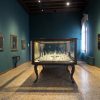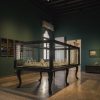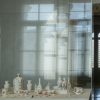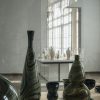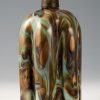At the beginning of the eighteenth century the competition with Bohemia had become a problem and there was no end in sight to the financial crisis. Despite local opposition, Giuseppe Briati (1686-1772), an enterprising inhabitant of Murano managed to assert himself by adapting to the times: he managed to get hold of the secrets of Bohemian glass and adapted the production of this kind of glass to the fashions and Venetian fantasy. He also invented renowned chandeliers with multiple crystal arms, decorated with festoons, leaves and multicoloured flowers (one of his original, magnificent pieces is displayed in Ca’ Rezzonico Museum in Venice, but this genre has continued ever since, in countless varieties). As an exception, he was granted permission to open a furnace in Venice where he also made engraved frames and mirrors as well as table centre pieces called deseri (from dessert), used as decoration for important occasions as well as many other fashionable objects, including furniture with inlaid glass.
Although the pieces on display here do not come from the Briati factory, they are excellent examples of the production in this period. For example, the Murano mirrors that were made following a complex procedure already in the sixteenth century and were still highly popular throughout the eighteenth century, with their lavish frames decorated with enamelled glass or with engravings that also frequently appeared on the mirror surface itself; another example is the large centre piece in crystal reproducing an Italian garden, datable to around 1760 and made of numerous pieces.
Another characteristic example of the fashion at that time are the fixè sous verre; these were drawings or – in our case – painted etchings that were pasted on glass with scenes inspired by the contemporary works by the Venetian painter Pietro Longhi. Renowned glass makers in the eighteenth century for the kind of objects on display here were Giuseppe Briati’s followers (Giacomo Giandolin, Lorenzo Rossetto, Zuane Gastaldello), Vittorio Mestre, Antonio Motta, and Vincenzo Moretti.
THE PLEASURE OF IMITATION: CHALCEDONY AND “LATTIMO” IN THE EIGHTEENTH AND NINETEENTH CENTURY
Created so they looked like different materials, various kinds of ‘imitation’ glass were very appreciated in the eighteenth century.
Examples include opaline glass, which looked like opal; opaque white glass, called “lattimo” (from the word for milk “latte”), which looked like porcelain and chalcedony, a variegated opaque glass with multicoloured veining, which looked like semi-precious stones such as banded agate, onyx, malachite and lapis lazuli.
Known already in the Roman age, chalcedony glass appeared in Murano during the Renaissance; it was made by mixing the remains of white, coloured or opal glass and crystal and adding different mixtures of substances once fused (such as copper, silver, cobalt, etc.) which resulted in its multicoloured veining.
At times, from the seventeenth century on, aventurine fragments were also added, resulting in further patches or streaks, for example in the two-handled eighteenth-century cup on display here. The “secret” of chalcedony was lost at the end of the century and it was not until the middle of the nineteenth century that it was revived; this was thanks to Lorenzo Radi who, in 1856, developed the same sixteenth-century composition, creating objects with simple, linear forms of the greatest effect owing to their vast chromatic range of the veining.
In 1861 Radi actually donated a large number to the newly founded museum, a considerable selection of which is on display here. Another kind of glass that was produced extensively in the eighteenth century was opaque white glass (“lattimo”), which had also been known in Roman times but was produced using different techniques and used as early as the end of the fifteenth century, imitating the earliest porcelain samples from China.
When porcelain began to be made in Europe as well in the eighteenth century, Venetian opaque glass also gradually became more and more famous; decorated with enamels and gold depicting genre scenes, chinoiserie, mythological subjects and rococo motifs, it was made using new production techniques.
Outstanding specialists in this field in Murano were the Miotti family, who sometimes signed their work, and the Bertolini brothers who, in 1739 had been given the exclusive right by the Republic to decorate their work with gold.
